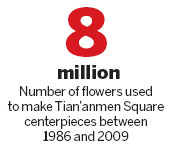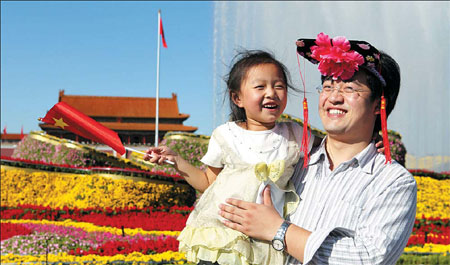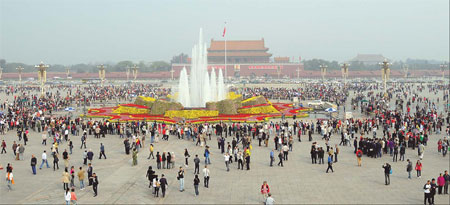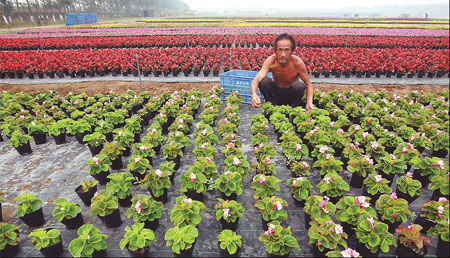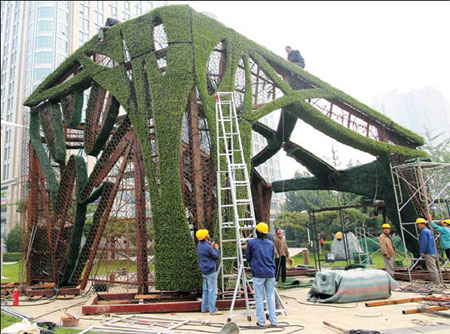Focus
Flower power sees Tian'anmen blossom
By Cheng Yingqi and Cao Li (China Daily)
Updated: 2010-09-27 08:02
 |
Large Medium Small |
|
Kai Xiaoxin from the Inner Mongolia autonomous region and his six-year-old niece, Li Mengran, enjoy the atmosphere on Tian'anmen Square in Beijing on Sunday. The square has been adorned with flower beds for the upcoming National Day celebrations. [Photo by Wang Jing/China Daily] |
|
Visitors gather at the newly completed National Day flower terrace at Tian'anmen Square in Beijing on Saturday. The display has been an annual tradition since 1986 and this year's centerpiece is a giant peony sculpture. [Photo by Liu Puquan/Xinhua] |
|
A Beijing Flowers and Trees Corporation horticulturist prepares flowers for the National Day display. |
|
Workers build a flower sculpture at Dongdan in downtown Beijing. |

Workers make capital bloom for National Day celebrations. Cheng Yingqi and Cao Li in Beijing report.
Walking through a field of flowers as colorful as a rainbow, Zhang Fuzhan bent down to gently blow dirt from the petals of a potted petunia.
Nearby, a handful of trucks were standing by to transport the pink plant and 200,000 other pots filled with French marigold, cockscomb, chrysanthemum, scarlet sage and crabapple to form the centerpiece of the National Day flower terrace in Beijing's Tian'anmen Square.
Zhang has spent months tending to the plants, watering them eight times a day and trimming their leaves, to ensure they were ready for celebrations to mark the 61st anniversary of the founding of New China on Oct 1.
His skin has turned a dark tan from the many hours wandering in the hot summer sun among the white and blue containers at the Tianhuiyuan Flower Study Institute's nursery in the capital's rural, northeastern Shunyi district.
Yet, the 55-year-old is one of thousands of landscape architects, horticulturists, gardeners and manual workers involved in designing, growing and erecting the extravagant floral sculptures that have been an annual tradition since the mid-1980s.
The centerpiece of this year's display, which was officially opened to the public last Saturday, is a giant blossoming peony, a flower that symbolizes peace and prosperity.
Built on a frame of 16 steel rods, the sculpture is 50 meters in diameter, while the highest petal stands at almost 3.2 meters tall.
More than 20 million plants will be placed at scenic spots across Beijing, including a variety of 45 species from home and abroad. More than 400,000 make up the peony display and two mosaics in Tian'anmen Square.
"All our seeds are imported from the United States, Germany and Japan, where breeding technologies are more mature, but they are grown here," said Bao Qingsong, manager of the Tianhuiyuan, which is part of the Beijing Flowers and Trees Corporation. "We usually don't use any rare species."
Bao's institute has produced about 2 million plants this year, including half of those used in the mosaics.
Growing ambition
Although the 2010 National Day decorations are considered relatively simple compared to those erected for the 2008 Beijing Olympics and the 60th anniversary of New China, they are still a giant leap from the early days of the tradition.
Starting in 1986, the first elaborate display was a simple alignment of some 100,000 colorful plants and flowers placed in Tian'anmen Square and along the adjoining Chang'an Avenue.
Mosaics and sculptures came later, followed by fountains and lighting facilities, with the theme changed every year to represent major events in the country's development, such as the Olympic Games or completion of the Three Gorges Dam hydro-electric project.
"The flowers not only reflect the advances in gardening technology but also the development of our country," said Lan Hailang, chief engineer at Florascape, a Beijing company that has designed the National Day's flower terrace since 2000.
About 8 million flowers were used to make Tian'anmen Square centerpieces between 1986 and 2009.
"Our work is becoming more and more difficult as the designs are getting increasingly sophisticated," said Song Xuedong, 40, an engineer with Tiancheng Dongsheng Decoration Company (also part of Beijing Flowers and Trees Corporation), who has worked on the floral decorations for the last 20 years.
For more than a decade, engineers used wooden frames to shape the plants into small wave formations. However, watering the display became problematic when the structure was too high.
Lan explained that Beijing's grand sculptures only became possible after China adopted the leading landscape technology exhibited during the 1999 World Horticulture Expo in Kunming, capital of Southwest China's Yunnan province. It allowed the use of lighting and steel frames to present more vivid and challenging forms.
Another milestone came in 2003 with the plug tray, a technique to separate plants into individual flowers that allows more complex designs.
"We've now narrowed the plant pot diameter to 11 cm (it was previously 30 cm)," said Lan. "It's just like a computer screen: The smaller the pixels, the more details you can display."
Usually, the frame of a large sculpture is divided into sections and covered with mud. After the flowers are inserted into pre-set positions, the frame is reassembled at Tian'anmen Square.
"It's just like using Lego blocks," said Lan, although he added the work is far from child's play.
"Safety is a priority. The structures are meant to provide a festive atmosphere and be a magnificent background for tourists to take pictures, so we don't want anything bad happening," he said. "Usually, the main landscape is 10 meters or so tall, plus we also can't fix the frame to the stone pavement."
More than 30 workers were hired to put together the peony sculpture's frame, with most of the transportation and construction work done at night to avoid disrupting traffic and tourists.
Blooming marvelous
The display in Tian'anmen Square will be taken down on Oct 15, with the flowers returned to the nurseries where they will be converted into compost or stored until next year. Frames are also often reused.
In the backyard of the Florascape workshop in Shunyi district stood two elephant sculptures that were placed in the Summer Palace last October and will this year adorn Chang'an Avenue.
However, Yan Hongfei, a researcher with the workshop, said redecorating a frame is not an easy job.
A proficient worker can at best insert 1.8 square meters of soil with flowers into a frame in eight hours, he said, explaining that the elephants, both 3 meters tall, have a superficial area of around 10 square meters. Last year, 22 similar plant creations were placed along Chang'an Avenue.
"We usually start making these half-finished sculptures in early August," Yan told China Daily. "We get them ready just before National Day. If we finish too early, we can't ensure they will blossom during the holiday period."
Florascape also grows its flowers at a nursery in Shunyi, which allows them to produce specially selected varieties to meet its requirements. However, in years with severe weather conditions, Lan Hailang said he will often change his design according to the flowers he has available.
"Thanks to decades of experience, we usually know the gross amount of flowers we will need, or at least we're sure how many red, yellow and pink flowers ones we have," he said. "Buying flowers from regions outside of Beijing is not the usual practice because it's more difficult to control their florescence due to different climates."
Horticulturists at the nursery regulate everything from the lighting to the hormones to ensure the flowers bloom at the right time, and will replace plants as soon as they begin to wilt. "If we need 100 pots of flowers, we often transport 150 pots as backup," said Li Qingxia, who was one of 10 engineers in charge of choosing the flowers and plants for this year's centerpiece design.
Despite the advanced technology, though, watering the grand display can still be a problem.
Every year, one of Li's jobs is to teach workers how to use the irrigation devices. She explained that all the potted flowers are fitted with a needle that delivers water to the root, while plug tray structures are fixed with sprays that allow flowers to remain abloom for about 30 days.
Li said she always chooses flowers that are resistant to strong sunlight and rainstorms, such as petunia hybrida, because the autumn weather in Beijing is very capricious.
The display for 2008 posed a difficult challenge, however. Due to Beijing hosting the Olympic Games and the Asia-Europe Summit, the flower terrace was kept on display from July until November.
"In the summer the flowers faced heavy rains and in November the weather was so cold that most flowers withered, meaning we had to use more lighting to create a beautiful effect," she added.
He Na contributed to this story.


